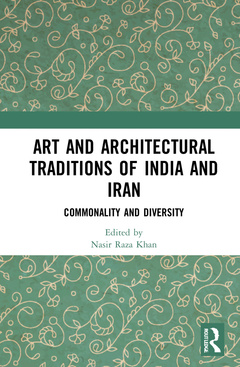Art and Architectural Traditions of India and Iran Commonality and Diversity
Coordonnateur : Khan Nasir Raza

This book presents a comprehensive overview of the historical and cultural linkages between India and Iran in terms of art and architectural traditions and their commonality and diversity. It addresses themes such as early connections between Iran, India and Central Asia; study of the Qutb Complex in Delhi; the great immigration of Turks from Asia to Anatolia; the collaboration of Indian and Persian painters; design, ornamentation techniques and regional dynamics; women and public spaces in Shahjahanabad and Isfahan; the noble-architects of emperor Shah Jahan's reign; development of Kashmir?s Islamic religious architecture in the medieval period; role of Nur Jahan and her Persian roots in the evolution of the Mughal Garden; synthesis of Indo-Iranian architecture; and confluence of Indo-Persian food culture to showcase the richness of art, architecture, and sociocultural and political exchanges between the two countries. Bringing together a wide array of perspectives, it delves into the roots of connection between India and Iran over centuries to understand its influence and impact on the artistic and cultural genealogy and the shared past of two of the oldest civilizations and regional powers of the world.
With its archival sources, this book will be useful to scholars and researchers of medieval history, Indian history, international relations, Central Asian history, Islamic studies, Iranian history, art and architecture, heritage studies, cultural studies, regional studies, and South Asian studies as well as those interested in the study of sociocultural and religious exchanges.
Introduction Part I: A Confluence of Traditions 1. The Qutb Complex: Iran and India 2. Mapping the Overlap between the Culture of Iranian "Turquoise and Emerald" with Indian "Saffron and Vermillion" 3. The Transition of the Khāksār to the Nāth Yogi via Gor Khatri 4. Caravanserais: A Synthesis of Indo-Iranian Architecture 5. Nuskha-i-Shah Jahani, A Confluence of Indo-Persian Food Culture 6. Myth and Mythology Related to Water in Indian and Iranian Culture: Connections and Continuity Part II: Regional Dynamics 7. The Mughal Gardens of Kashmir: A Cultural Perspective 8. Transformation of a "Hindu" City into a "Muslim" Capital? Factual and Fabled Mohammadabad Champaner under the Sultans of Gujarat 9. The Major Mughal Buildings of Thatta in the Seventeenth Century: A Synthesis of Central Asian, Classical Mughal and Local Architecture 10. Development of Kashmir’s Islamic Religious Architecture in the Medieval Period: Synthesis and Continuity Part III: India and Iran: Historical Perspectives 11. Imperative Role of Nur Jahan and her Persian Roots in the Evolution of Mughal Garden Tombs 12. Impact of Persian Ghazals on Mughal Monuments 13. Shaikh Abdul Haq: A Traditionalist of Bokhara in Delhi 14. Following the Traces of the Great Migration of Turks from Asia to Anatolia 15. Cultural and Architectural Engagements between India and Iran: A Study of Indian Literature Through the Ages
Nasir Raza Khan is Associate Professor in the India-Arab Cultural Centre, Jamia Millia Islamia, New Delhi, India. He was former Visiting Professor (ICCR Chair) at the Lebanese American University, Beirut, Lebanon, and Former Director of the L.B. Shastri Centre for Indian Culture, Embassy of India, Tashkent, Uzbekistan.
Date de parution : 09-2023
15.6x23.4 cm
Date de parution : 11-2021
15.6x23.4 cm
Thème d’Art and Architectural Traditions of India and Iran :
Mots-clés :
Shah Jahan; Nur Jahan; India-Iran; Humayun’s Tomb; Indo-Persian; Jama Masjid; architectural traditions; Alauddin Khalji; art; Jami Mosque; music; Persian Ghazals; food; Chahar Bagh; culture; Mughal Painting; Sufism; Holy Man; cultural interactions; Fatehpur Sikri; ethno-religious exchange; Oriel Windows; myths; Prayer Chamber; mythology; Indus Valley Civilization; knowledge transfer; Firoz Shah Tughluq; Iranian and Indian architecture synthesis; Zain Al Abidin; Turks; Mughal Rule; architecture; Tamil Nadu; Asia; Persian Language; Anatolia; Long Horn; Mughal; Quwwat Al Islam; Sind; Chandni Chowk; Buildings; Dal Lake; Indo-Iran Relations; Hasht Bihisht; Persia; Caravanserais Architecture; ‘Public’ Women; Public Spaces; India and Iran; Mughal Garden Tombs



